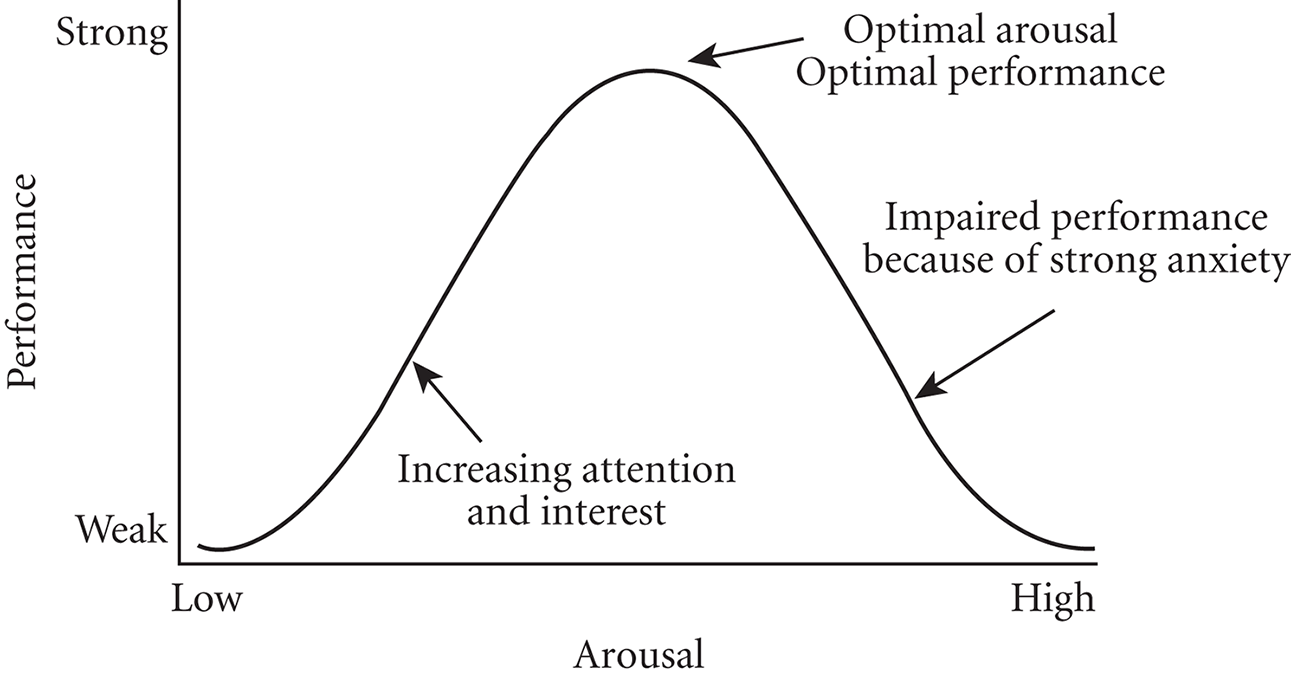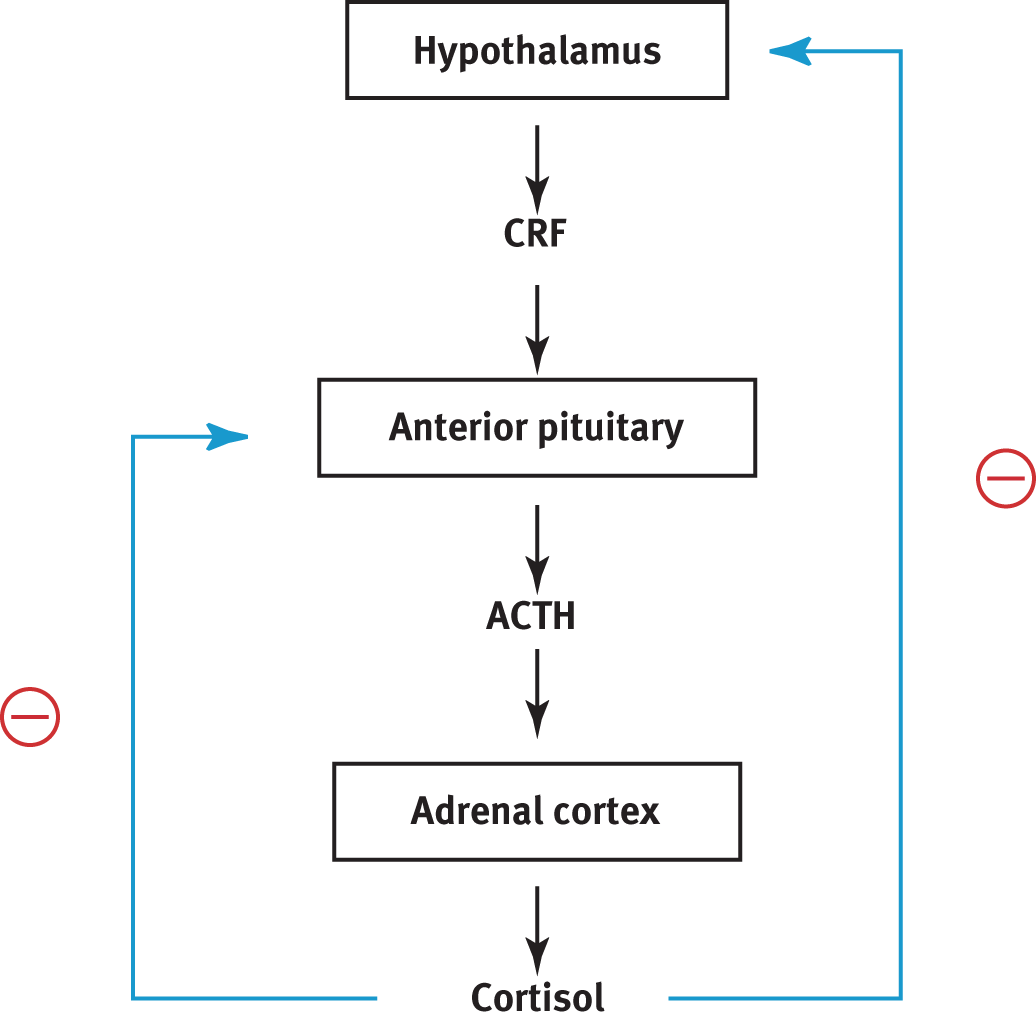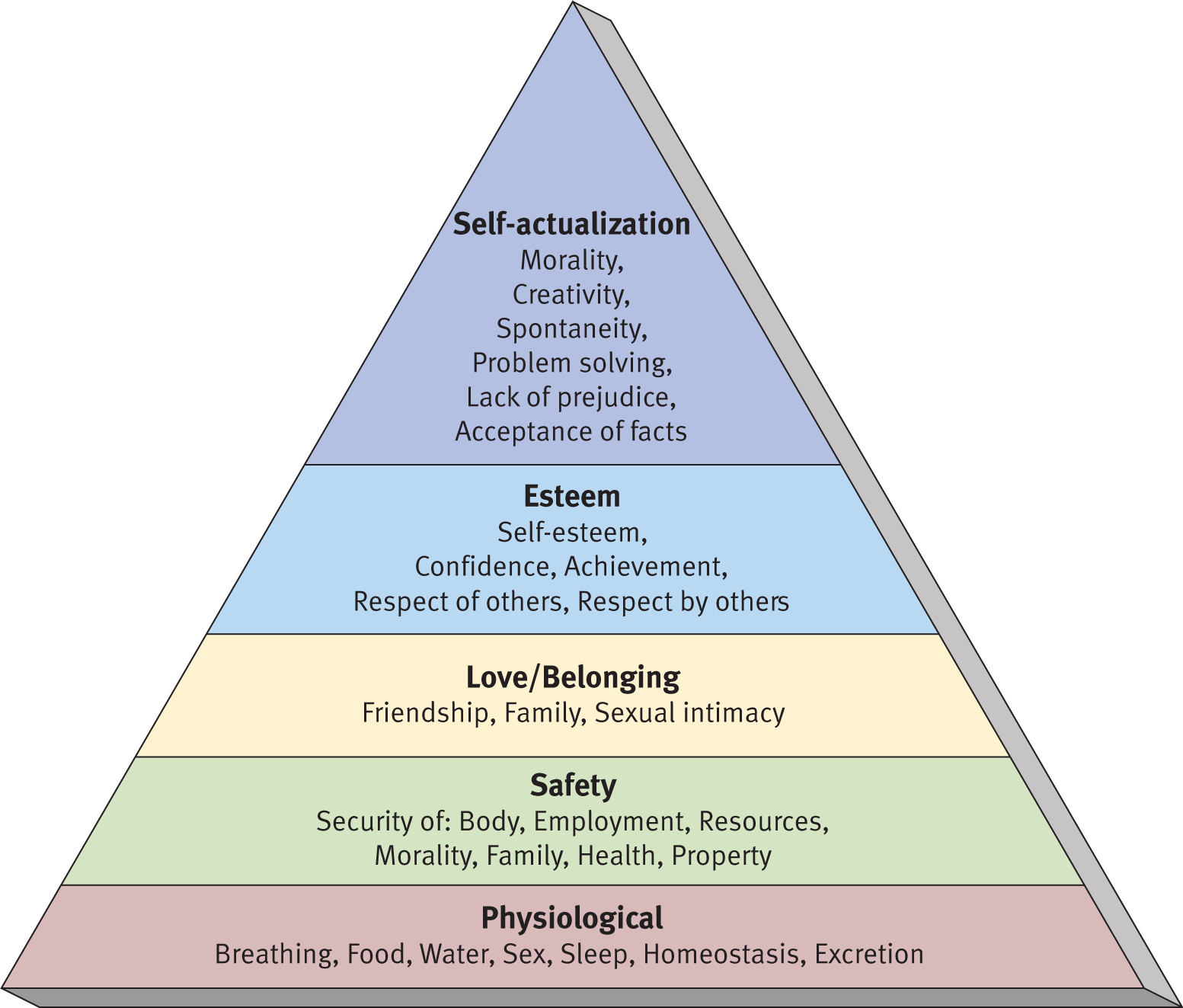
After Chapter 5.1, you will be able to:
Motivation is the purpose, or driving force, behind our actions. The word derives from the Latin movere, meaning “to move.” There are many examples of motivation in our everyday lives. As you sit, studying for the MCAT, you realize you are thirsty, so you reach for your water bottle. When you realize it is empty, the need to quench your thirst drives you to get up, walk to the kitchen, and fill the bottle with water. Thus, the physical state of thirst motivated an action. The desire to go to medical school and become a physician has motivated you to complete required undergraduate coursework, strive for a competitive GPA, participate in extracurricular activities, and dedicate your time to study for a standardized test. The goal of staying fit and healthy motivates many to spend hours in the gym, while the initial discomfort of physical activity might motivate others to stay sedentary. Motivation can be directed toward minimizing pain, maximizing pleasure, or it can be rooted in a particular physical need such as eating, drinking, sleeping, or sex.
Motivation can be categorized based on what drives people to act. These drives can be external forces, such as rewards and punishments, or internal forces, where the behavior is personally gratifying. External forces, coming from outside oneself, create extrinsic motivation. Extrinsic motivation can include rewards for showing a desired behavior or avoiding punishment if the desired behavior is not achieved. Examples of such motivation include working hard at your job for praise from your boss, practicing regularly for a sport so that you will perform strongly in an upcoming game, or studying for months on end to achieve a high score on the MCAT. Each of these acts result in external, tangible rewards. Extrinsic motivation can also include doing chores to avoid punishment and working to avoid being fired. Competition is a strong form of external motivation because a person is incentivized to beat others and not only to win, perform, or achieve for him- or herself. Motivation that comes from within oneself is referred to as intrinsic motivation. This can be driven by interest in a task or pure enjoyment. A student who takes interest in the subject matter at hand and has the goal of mastering the content is driven by intrinsic motivation, while the goal of achieving high grades is considered extrinsic.
Intrinsic motivation can be reduced by introducing external reward into a scenario. In one study, children were given art supplies and told to draw. Some children were told they would receive a gold ribbon for their drawing, while others were not. Those who knew of the potential reward were driven by extrinsic motivation and spent less time drawing, acting only to receive the reward. Children who did not know about the reward drew for the sake of drawing—by intrinsic motivation—and spent more time drawing.
The primary views of motivation include instincts that elicit natural behavior, the desire to maintain optimal levels of arousal, the drive to reduce uncomfortable states, and the goal of satisfying physiological and psychological needs.
Early attempts to understand the basis of motivation focused on instincts, which are innate, fixed patterns of behavior in response to stimuli. For example, wolves are instinctively pack creatures that naturally follow the alpha male of their group. Additionally, they are highly territorial creatures, protecting areas that are much larger than needed to hunt and dwell. This protection includes scent-marking, howling, and direct aggressive attacks on intruders. Humans also have instinctive behavior; for example, thumb sucking is an instinctual response to stress in babies that is aimed at self-soothing. As discussed in Chapter 1 of MCAT Behavioral Sciences Review, primitive reflexes like the grasp reflex, shown in Figure 5.1, are also instinctual. Note that some instincts last for the entire lifetime, while others may appear or disappear with age.

According to the instinct theory of motivation, people are driven to do certain behaviors based on evolutionarily programmed instincts. This theory was one of the first to describe motivation and was derived from Darwin’s theory of evolution. William James, the father of modern psychology, was one of the first to write about human instincts in his 1890 publication of Principles of Psychology. He stated that humans were driven by many instincts, possibly more than any other animal studied. James suggested that human actions are derived from 20 physical instincts, including suckling and locomotion, and 17 mental instincts, including curiosity and fearfulness. However, he said that many of these instincts were in direct conflict with each other and could be overridden by experience. Arguably the greatest proponent of instinct theory was William McDougall, who proposed that humans were driven to all thoughts and behaviors by 18 distinctive instincts, including flight and acquisition. James and McDougall postulated that the instincts of suckling and carrying food to the mouth result in naturally motivating one to eat.
An instinct is an innate, fixed pattern of behavior in response to a stimulus. It may be consistent throughout life, or it may appear or disappear with time.
Another factor that influences motivation is arousal, the psychological and physiological state of being awake and reactive to stimuli. Arousal involves the brainstem, autonomic nervous system, and endocrine system, and plays a vital role in behavior and cognition.
Arousal theory states that people perform actions in order to maintain an optimal level of arousal: seeking to increase arousal when it falls below their optimal level, and to decrease arousal when it rises above their optimum level. Additionally, the Yerkes–Dodson law postulates a U-shaped function between the level of arousal and performance. This law states that performance is worst at extremely high and low levels of arousal and optimal at some intermediate level, as depicted in Figure 5.2. The optimal level of arousal varies between different types of tasks: lower levels are optimal for highly cognitive tasks, while higher levels are optimal for activities that require physical endurance and stamina. Further, simple tasks generally require slightly higher arousal than complex tasks.

While a moderate level of arousal is optimal for performance, certain individuals seek out higher levels of arousal. These people may seek out dangerous activities, such as skydiving or bungee jumping, and are considered adrenaline junkies. These individuals are sometimes found to have lower levels of monoamine oxidase (MAO), which breaks down catecholamines. Low levels of MAO result in higher neurotransmitter levels, which may lead to motivation to experience high levels of arousal.
Drives are defined as internal states of tension that activate particular behaviors focused on goals. Drives are thought to originate within an individual without requiring any external factors to motivate behavior. In other words, drives help humans survive by creating an uncomfortable state, ensuring motivation to eliminate this state or to relieve the internal tension created by unmet needs. Primary drives, including the need for food, water, and warmth, motivate us to sustain bodily processes in homeostasis. Homeostasis is the regulation of the internal environment to maintain an optimal, stable set of conditions. In homeostatic regulation, external factors are encountered, and the system will react to push the system back to its optimal state.
Homeostasis is usually controlled by negative feedback loops. A common real-life example of a negative feedback loop is a thermostat. A thermostat is set to a desired temperature, and then sensors monitor the air temperature in relation to this desired temperature. If the air temperature gets too cold, the heater will turn on; if the temperature gets too warm, the heater will turn off. Negative feedback loops in the body operate the same way. When our bodies are lacking nutrients and energy, feedback systems release hormones like ghrelin that create a hunger drive and motivate eating. After we consume food, feedback is sent to the brain to turn off the hunger drive through hormones like leptin. Hunger is a complex feedback system involving these hormones, receptors in the walls of the stomach, levels of glucose (maintained by the liver), and insulin and glucagon levels (released by the pancreas). The concentrations of many hormones of the endocrine system are regulated by three-organ “axes,” such as the hypothalamic–pituitary–adrenal axis shown in Figure 5.3.

Additional drives that are not directly related to biological processes are called secondary drives. These drives are thought to stem from learning. The drive to matriculate into medical school and become a physician is an example of a secondary drive. Secondary drives also include certain emotions, such as the desire for nurturing, love, achievement, and aggression.
Primary drives are those that motivate us to sustain necessary biological processes. Secondary drives are those that motivate us to fulfill nonbiological, emotional, or “learned” desires.
Drive reduction theory explains that motivation is based on the goal of eliminating uncomfortable states. Theorists hypothesize that certain physiological conditions result in a negative internal environment. This internal environment then drives motivation and seeks homeostasis in order to reduce the uncomfortable internal state.
Needs are also motivators that influence human behavior. Through this lens, motivation can be described as how we allocate our energy and resources to best satisfy these needs. Motivation thus determines which behaviors are most important to pursue, how much effort will be taken, and for how long the effort will be maintained.
Abraham Maslow observed that certain needs will yield a greater influence on our motivation and established what is referred to as Maslow’s hierarchy of needs. Maslow classified needs into five groups, and assigned different levels of priority to each group. The hierarchy is typically displayed as a pyramid, as shown in Figure 5.4, where the most primitive, essential, and important needs are at the base. The first four levels of the pyramid correspond to physiological needs, safety and security, love and belonging, and self-esteem. The highest level of the pyramid corresponds to self-actualization, or the need to realize one’s fullest potential. Maslow theorized that if the lowest level of need is not met, motivation to meet that need will be the highest priority. Once that need is met, if additional needs exist, they will be satisfied based on priority. For example, a person’s most basic motivation will be to satisfy physiological needs, followed by the need to establish a safe and secure environment.

Another need-based motivational theory is the self-determination theory (SDT). SDT emphasizes the role of three universal needs: autonomy, the need to be in control of one’s actions and ideas; competence, the need to complete and excel at difficult tasks; and relatedness, the need to feel accepted and wanted in relationships. Theorists explain that these three needs must be met in order to develop healthy relationships with oneself and others.
There are two other theories of motivation that you want to know for the MCAT: incentive theory and expectancy-value theory. Incentive theory explains that behavior is motivated not by need or arousal, but by the desire to pursue rewards and to avoid punishments. Expectancy–value theory states that the amount of motivation needed to reach a goal is the result of both the individual’s expectation of success in reaching the goal and the degree to which he or she values succeeding at the goal.
Knowing the four primary factors that influence motivation is key for Test Day: instincts, arousal, drives, and needs. The MCAT will expect you to know the common theories for explaining motivation.
There are many motivations that stem from biology but that are impacted by additional psychological and sociocultural factors. One of the strongest natural motivations is hunger. However, people often eat for the sheer pleasure of the act, a motivation that has led to obesity occurring at alarming rates in the United States. Societal and cultural norms can determine what types of foods one eats and when. For example, some cultures have a traditional diet very high in fat and participate in many social activities involving food. At the other extreme, anorexia nervosa is also correlated to biological and cultural factors. It has been observed that those suffering from the disease are more likely to suffer from personality disorders as well. The prevalence of anorexia in the United States has increased significantly in the last several decades as the societal concept of beauty has changed from more full-bodied idols to extremely thin cultural icons.
Motivations are considered destructive if they result in harm to oneself. For example, drug abusers can be motivated to take drugs by the pleasure experienced when taking the drug or by the removal of withdrawal symptoms. While there are many “hard” drugs available, the most commonly used psychoactive substances in the United States are caffeine, nicotine, and alcohol. A theory of motivation that explains continuous drug use is the opponent-process theory. This theory explains that when a drug is taken repeatedly, the body will attempt to counteract the effects of the drug by changing its physiology. For example, the body will counteract repeated use of alcohol, a depressant, by increasing arousal. The problem with this reaction is that it will last longer than the drug, resulting in withdrawal symptoms that are exactly opposite the effects of alcohol: sensations of anxiety, jitteriness, and irritability. The withdrawal created by this mechanism can create a physical dependence on the drug. Opponent-process theory can also explain tolerance, a decrease in perceived drug effect over time. Cultural and demographic factors also affect drug use. Young adults are the most likely age group to smoke, with a decline in smoking rates seen as the group ages. Smoking is also seen more commonly in disadvantaged socioeconomic groups. Across the globe, smoking rates are highest in Eastern Europe; this creates visibility, leading to additional pressure or desire to smoke in these communities.
Sexual motivation is another area that has been widely studied. In 1948, Alfred Kinsey reported his findings on sexual behavior from interviews with people from a broad range of sociocultural backgrounds. Kinsey hoped to identify what sexual behaviors people were participating in, how often, with whom, and at what age they began. William Masters and Virginia Johnson published another important study of sexual motivation. The study involved physiological measurement of sexual arousal, proving that men and women experience similar physical responses. The most notable differences seen between the sexes were based on cultural influences and learned behavior.
Physiologically, humans are motivated to sexual behavior based on the secretion of estrogens, progesterone, and androgens. There is a strong correlation between hormone concentration and sexual desire. Another biological factor for sexual motivation is smell. Certain odors have been shown to increase sexual desire and activity. Pleasure and the interpretation of pleasure is also a key player in sexual motivation and one that is highly influenced by culture. One study measured physiological arousal based on watching sexually explicit videos. The results showed that both men and women experienced the same levels of arousal, but women more often reported being unaroused or having feelings of disgust based on subjective interviews. This study demonstrated that cognition plays a role in sexual motivation. Additionally, culture and society influence what is deemed appropriate sexual behavior, the age at which it is deemed appropriate, and with whom. Cultural norms and conditioning influence the desire for sexual interaction, or lack thereof.